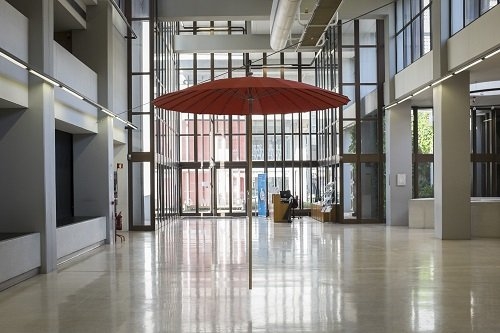The Grass is Always Grenner brings together contemporary Austrian, Danish and Portuguese artists. On first reading it may seem that this is an exhibition giving an overview of artists from specific countries. A quick look at the three countries reveals that they are all small and have borders with larger countries with which they have had a difficult history and continue to have a strange relationship based on comparisons. A closer look allows us to draw a parallel with the human condition and to identify a series of dichotomies that characterise it. The narrative that informs this exhibition seeks to trigger precisely this process of identification. The characters (the works) in the narrative come together in a series of dichotomies: the large against the small; the illusion of what the other appears to be and the reality of what it really is; the relationship between the observer and the observed; and the contradiction between the unfamiliar and the familiar.
The work of Katharina Lackner (1981) addresses three of these dichotomies: large and small; illusion and reality; and the familiar and the unfamiliar. A gigantic umbrella (Slide, 2009-2013) hangs from the ceiling, and we can walk beneath it across the hall. The experience of holding this super sized umbrella transports us to a place of childhood, as though we were a character in a story such as Jonathan Swift’s Gulliver’s Travels (1726). The large-scale photograph of a mountain (Mountain, 2013) by Gregor Graf (1976) creates a sensation of transcendence. The overwhelming sense of the sublime, of finding something much greater than we can comprehend, is very powerful. O Passageiro (2011) by Nuno Cera (1972) also makes reference to this, with a journey that involves a web of movements, entering and exiting sea caves, in which we are sometimes observers but sometimes exposed, leaving us in a limbo between the fascination for the unknown and the need for refuge. In the enormous circus cage (Cage and Mirror, 2011) by Jeppe Hein (1974) we are also both observers and observed at the same time, in an exhibition as unavoidable as it is undesirable.
The great detail of the route in Heim (2008) by Claudia Larcher (1979) responds to our desire to look into a house full of stories that we do not share, resulting in a feeling of strangeness (Unheimlich), as opposed to the familiarity of the home (Heim). Encircled (2014), by the AVPD duo (Aslak Vibaek, 1974 and Peter Doessing, 1974) lays bare the emotional tension felt when one is surrounded. From the outside, the cylindrical structure appears light. From the inside, however, the complex matrix seems to wall us in.
In the set of boxes in Untitled, metal object (2008) by Tove Storch (1981), each seems to be trying to be higher than the others in an absurd competition between entities that are extremely similar. Competitiveness is also a feature of Sustenido (2014) by Dalila Gonçalves (1982). What appears to be a drawn horizontal line actually turns out to be a set of hands for large and small clocks, impeding each others’ movements. This is Goodbye (2014) by Ann Louise Overgaard Andersen (1977) looks at relationships between large and small bodies with three interlinking blocks that appear to form a house. The central and largest block is deliberately anticlimactic: the ways through to the interior always lead us into empty space. Pays/scope (2012) by Miguel Palma (1964) provides a contrast with the purposely anticlimactic feeling of This is Goodbye. The mirror at the top of the tower confronts us from atop a height of six metres, showing us that we have been observed by a telescopic sight.
A sense of confrontation fuels the surprises that jump out at us throughout this exhibition: the confrontation with things that are bigger than us; the confrontation between idealisation and reality; and the confrontation between the desire for the unknown and the need for refuge. These points of confrontation reveal that we belong to a common social realm that transcends geographical borders: from here (wherever it may be) the grass seems always greener.
Descobrir Education Programme
The education department provides group gallery talks in English by appointment.
Information/Booking:
descobrir@gulbenkian.pt
Phone: + 351 21 782 3800
www.descobrir.gulbenkian.pt
Daqui Parece Uma Montanha / The grass is always greener
Austrian, Danish and Portuguese contemporary artists
Curator: Luísa Santos
CAM Gulbenkian, Lisbon - Hall, Level 0, Room A and Room B
5 June to 21 September 2014
http://www.cam.gulbenkian.pt/index.php?article=72669&visual=2&queryParams=orderby|asc,data_i|2013,tipo_ano|ano&position=1&queryPage=0&langId=2

Slide - Slide, 2011 Katharina Lackner Photograph by Paulo Costa